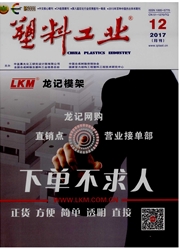

 中文摘要:
中文摘要:
为了研究超声波作用下的聚合物材料流动性能及其影响因素,利用自主开发的聚合物超声波辅助挤出测试系统,进行了超声波作用下聚合物熔体在微流道管壁的剪切力、剪切速率和表观黏度的测试,并在与传统稳态挤出相比较基础上,分析了超声波对微流道中聚合物熔体流动性能的影响。实验结果表明,引入超声振动后,微流道的入口压力降有明显降低,并且随着熔体剪切速率的增加而增大;超声振动作用下聚合物熔体剪切速率存在临界值,当剪切速率小于临界值时,超声下聚合物黏度小于传统稳态挤出聚合物黏度,反之,超声聚合物黏度大于传统挤出聚合物黏度。
 英文摘要:
英文摘要:
To study the rheological behavior of melting polymer under the action of the ultrasonic vibration and its influencing factors, a self-made ultrasonic-assisted polymer extrusion measurement system was developed and used to ultrasonic-assisted extrusion experiments. The shear stress, shear rates and apparent viscosity of melting polymer in micro-channel under ultrasonic vibration were measured. By comparison with traditional steady-state extrusion results, the rheological behavior of melting polymer under the action of the ultrasonic vibration was studied, it was found that after the introduction of ultrasonic, micro-channel inlet pressure drop decreased obviously and increased with the melt shear rate increased. In extrusion experiments, there existed a polymer melt shear rate threshold value. When the shear rate was less than the threshold, polymer viscosity under the action of the ultrasonic was smaller than the traditional steady-state viscosity, and vice versa.
 同期刊论文项目
同期刊论文项目
 同项目期刊论文
同项目期刊论文
 期刊信息
期刊信息
